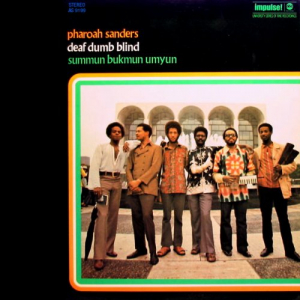Pharoah Sanders - Deaf Dumb Blind (Summun Bukmun Umyun) 'July 1, 1970

| Artist | Pharoah Sanders Related artists |
| Album name | Deaf Dumb Blind (Summun Bukmun Umyun) |
| Country | |
| Date | July 1, 1970 |
| Genre | Jazz |
| Play time | 39:02 |
| Format / Bitrate | Stereo 1420 Kbps
/ 44.1 kHz MP3 320 Kbps |
| Media | CD |
| Size | 251 MB |
| Price | Download $2.95 |
Order this album and it will be available for purchase and further download within 12 hours
Pre-order album Tracks list
Tracks list
Tracks 1. Summun Bukmun Umyun 2. Let Us Go Into The House Of The Lord Personnel Pharoah Sanders (flute, percussion, piano, soprano sax, whistle) Gary Bartz (bells, cowbell, percussion, alto sax) Woody Shaw (martenot, percussion, trumpet) Lonnie Liston Smith (cowbell, martenot, percussion, piano) Anthony Wiles (conga, drums, percussion, african percussion) Nat Bettis (percussion, yodeling) Cecil McBee (bass) Clifford Jarvis (drums) After Karma was issued and Sanders had established himself -- to himself -- as a musician who had something valuable and of use to say, he was on what this critic considers to be a divinely inspired tear. Deaf Dumb Blind is an example of that inspiration. Beginning with the title cut, a suite of over 21 minutes, Sanders brings in the whole of his obsession with rhythm and R&B. Using African percussion, bylophones, shakers, cowbells, and all manner of percussion, as well as drummer Clifford Jarvis, Sanders brought in Cecil McBee to hold down the bass chair and Lonnie Liston Smith back in on piano, and added a three-piece horn section that included Gary Bartz on alto and Woody Shaw on trumpet in addition to himself. Whew! Here the Latin and African polyrhythms collide and place the horns, as large and varied as they are, in almost a supplementary role. The horns check counterpoint in striated harmony, calling and responding over the wash of bass and drums and drums and drums! It evolves into a percussion orgy before the scary otherworldly multiphonic solos begin. And Shaw and Bartz are worthy foils for Sanders. And no matter how out it gets, those rhythms keep it rooted in the soul. Let Us Go Into the House of the Lord is almost 18 minutes in length. It has a long soprano intro, covered in shimmering bells and shakers with a glorious piano fill by Smith, who becomes more prominent, along with some excellent arco work by McBee, until the piece becomes a meditation on lyricism and silence about halfway through. The entire band eventually rejoins for a group ostinato with very little variation, except in timbre and subtle accented color work by Sanders and McBee. It is a stunningly beautiful and contemplative work that showcases how intrinsic melodic phrasing and drones were to Sanders at the time -- and still are today. This piece, and this album, is a joyful noise made in the direction of the divine, and we can feel it through the speakers, down in the place that scares us. Thom Jurek
Related artists
Pharoah Sanders
Album
- July 13, 1987 Oh Lord, Let Me Do No Wrong
- July 1, 1970 Deaf Dumb Blind (Summun Bukmun Umyun)
- 2024 Keystone Korner, San Francisco 1971
- 2023 Pharoah
- 2023 Harvest Time Live 1977
- 2023 Duo Concert In Frankfurt 1986 Vol. 1-2
- 2023 Live at Fabrik Hamburg 1980
- 2015 The Creator Has a Master Plan
- 2013 Spiritual Blessings
- 2006 The Impulse Story
- 2005 Pharoah's First
- 2003 Meditation: Selections, Take 1
- 2003 Meditation: Selections, Take 2
- 1999 Crescent With Love
- 1999 Save Our Children
- 1998 Izipho Zam
- 1998 Save Our Children
- 1997 Priceless Jazz 10: Pharoah Sanders
- 1996 Message From Home
- 1994 Journey To The One
- 1993 Tauhid
- 1993 A Prayer Before Dawn
- 1992 Ballads With Love (2010 Remaster)
- 1991 Welcome To Love
- 1989 Moon Child [2]
- 1989 Oh Lord Let Me Do No Wrong
- 1987 Africa [2]
- 1987 Thembi
- 1982 Heart is a melody
- 1981 Live
- 1981 Rejoice [2003, Japanese Edition]
- 1981 Beyond A Dream (Live at Montreux Jazz Festival - July 22, 1978)
- 1980 Journey To The One
- 1978/2012 Love Will Find a Way (Expanded Edition)
- 1977 Pharoah [Deluxe Edition, 2CD]
- 1975 Live In Paris (1975) [2020, re-issue]
- 1973 [2007] Love in Us All
- 1973 Elevation
- 1973 Village Of The Pharoahs
- 1973 Wisdom Through Music [2019 Remastered]
- 1972 Live At The East
- 1971 Thembi
- 1971 Black Unity [1997 Remastered, US]
- 1970 Summun, Bukmun, Umyun
- 1969 Karma
- 1969 Izipho Zam
- 1969 Jewels Of Thought
- 1965 Pharoah Sanders Quintet
- 1965 Pharoahs First
- 1964 Pharoah's First (2005 Remastered)
Anthology
Bootleg
- 2018 2018-12-04, Birdland, New York, NY
- 2015 2015-06-05, Bay 20, Carriageworks, Eveleigh, Sydney, Australia
- 2013 2013-05-03, Porgy & Bess, Vienna, Austria
- 1999 1999-01-04, The Great Hall, Oakland Museum, Oakland, CA
- 1999 1999-06-20, Yoshi's, Oakland, CA
- 1997 1997-07-23, Yoshi's, Oakland, CA
- 1997 1997-12-27, Gem Theater, Kansas City, MO
- 1996 1996-07-03, Hot Brass, Paris, France
- 1996 1996-07-05, Kammer Oper, Wien, Austria
- 1995 1995-03-10, Iridium, New York, NY
- 1995 1995-03-11, Iridium, New York, NY
- 1994 1994-04-15, Village Vanguard, New York, NY
- 1994 1994-04-16, Village Vanguard, New York, NY
- 1994 1994-06-28, Du Maurier Jazz Festival, Toronto, ON
- 1992 1992-10-13, Village Vanguard, New York, NY
- 1991 1991-07-XX, Espace Julien, Marseille, France
- 1987 1987-08-05, Yoshi's, Oakland, CA
- 1987 1987-08-03, Kuumbwa Jazz Center, Santa Cruz, CA
Live album
